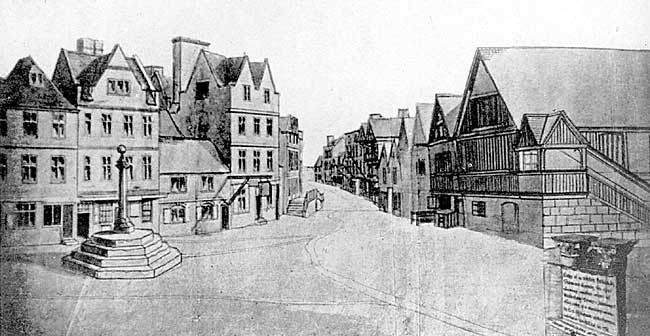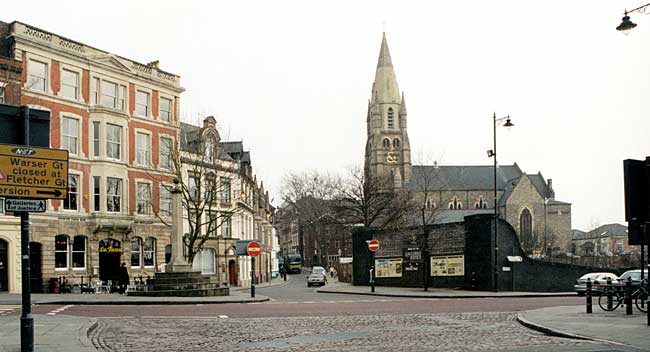WEEKDAY MARKET.

Weekday Cross in 1741.
Numerous and greatly varied in their character are the memoranda in the archives of the town, relating to the market at Weekday Cross—too many to produce here and now. A selected few between the years 1300 and 1750, must suffice for present purposes.
In 1308-9, two persons were charged by the Decannaries or Constables with stealing in the "Daily Market."
In 1375, a tavern was leased for ten years. This was described as "our tavern lying under our tenement in the "Daily Market, opposite the chapel. The rental was 13s. 4d., payable in two instalments. The lessees were Hugh de Spicer and his son William; and the tenant, Thomas le Taverner of Nottingham. This chapel, in honour of St. John, was erected in "Wykeday" Cross, in 1340, by John Baston. This Baston, ten years earlier, was made custodian of the waters, mills, meadows, and the rabbit warren in Nottingham.
In 1384-5 was leased to a butcher "a vacant piece of ground 16 feet in length and 12 in breadth, lying in the 'Wykday Market,' near the King's Highway, which leads from Flesshewergate to the Middle Pavement towards the south, at a rent of twelve pence in silver."

Weekday Cross in 2001.
The Mickleton Jury,1 in 1395, presented one William de Stapleton, for blocking up the common street with refuse, towards "Flexschamulles," in the "Wykeday merkeyth," on a street called Calvertonlayne, to the "series detriment of the whole community, and the great obstruction of the water of Lene near Frerwater-gonge, &c."
The records of 1406 refer to "a messuage which lies in the Flesh ameles in the Daily Market."
The Mickleton Jury of 1553 reported two Butchers' shops as "being a nuisance." The jury thought it "necessary that they should be removed to another part of the Market."
The Chamberlains' Rentals for 1573-4, showed that one Richard Barret paid two shillings "for a chimney and two out castes or purpestures to his house agaynst Wekeday Crosse, taken of the common ground."
The Churchwardens' books of St. Mary's parish for 1583, contain the names of seventeen residents in the Weekday Market. They are John Bayarde, Maister Dodson, Ellys Graterakes, Roger Lyne, Maister Stancyalle, Richard Barrett, John Ellys, Wydoe Buttrye, Rolphe Hamforthe, W. Wryghte, William Reason, Isaache Newbolde, John Tomson, Rycharde Goldryng, and Wydoe Lyne.
In the Churchwardens' books of St. Mary's, of 1582-3, is this entry:—"Harry Welche for a shop in ye Wekeday Shambelles, due at Candylmas. lxs."
John Askew was in 1587, presented by the Mickle-torn Jury "for his shop standing uppon the Weekday Crosse," but the complaint was discharged by the Mayor and Justices.
Among the items of town expenditure associated with the Weekday Cross district, during the first half of the eighteenth century, were these:—
1726 |
Dec. 21—Cleaning about Weekday Cross and Munday Cross—6s. 0d. |
1729 |
Nov. 7—"It is agreed that Thomas Smith shall sweep and carry away the dirt out of the Great Market Place . . . Weekday Cross (&c.) which the Chamberlains used to cleanse" (etc.). |
1733 |
Oct. 12—"This day Edward Collishaw and William Foulds agreed to clean all the streets, Market Places . . . which Thomas Smith lately did." |
1745 |
Sep. 16—"The Corporation Debtor to Samuel Wheatcroft for paving by the Weatday Cross—5s. 3d. |
In 1739 there were only fifteen houses in the restricted area then known as Weekday, with a population of fifty-seven, but in the northern extension of that space known then as Blowbladder Street (previously as Mont Hall Gate, and later as Market Street) there were nineteen houses and eighty-nine souls—in all thirty-four houses and 146 persons. These persons were residents, not stallholders.
The Monday Market in St. Peter's Square not having proved a success it was closed, as Stretton notes, and was removed back to the south end of Blowbladder Street, and a new cross erected there called the Weekday Cross on the site of an old one.
Writing near the middle of the eighteenth century, Deering records that at the Weekday Cross "the Wednesday and Friday Market is kept for Butter, Eggs, Pidgeons, wild Fowl, and all kinds of Fruit in season; besides on Fridays here are sold sea and river fish," and notes that "near this Cross stands other Shambles, placed north and south, where all the week, except on Saturdays, the Butchers sell all kinds of fleshmeat."
In 1773, on May 22nd, Mrs. Mary Collin died at the house of her brother, John Collin, a wealthy citizen of Nottingham, at Weekday Cross.
From a Poor Rate Book for 1784, we learn that the following persons were rated for premises in Weekday Cross:—Mrs. Greasley, Mrs. Wordsworth, John Linaker, W. Wright, Rd. Smith, Mrs. Partridge, H. Worrall, Mr. Severn, Jas. Thorman, Mrs. Hooper, Francis Cropland, Mrs. Dodd, Mr. Hill, Jas. Greenfield, Mrs. Else (probably at the "Crown and Cushion"), John Calvert, Mr. Faulkner, W. Viezie, Mrs. Deverall, Rev. Mr. Launder, Mrs. Dale (widow of Councillor Richard Dale, druggist), Robt. Frost, W. Taylor, Caunt and Hill, S. Morley ("Shepherd and Shepherdess") Miss Stanhope, and J. Chapman.
In the 1799 directory, the names and railings of fifteen householders in "Weekday Cross" and nine in Blowbladder Street were given. They are as follows:—
Week-Day-Cross—James Bigsby, Wine Merchant, &c.; Rd. Bonington, Keeper of the Town Gaol; Rev. Brown, Charity School; Aid. Thos. Caunt, Hosier; J. Dale, Druggist; Robt. and Rd. Gresham, Pawnbrokers; John Holt ("Barley-mow"); Sam Morley, Victualler ("Shepherd and Shepherdess"); Wharton Partridge, Apothecary; Benj. Stoney, Joiner; John Taylor, Gent.: John Tomlinson, Wine and Liquor Merchant: Stephen Weston, Joiner, &c.; Rev. Robt. Wood, Curate of St. Mary's Church; Mrs. Worrell, Widow, and Benjamin Stoney, Joiner, who purchased the cross, and whose premises were near the eastern end of the Town Hall.
Blowbladder Street—Sam. Beardsley; William Cook, Plumber and Glazier; Mrs. Else, Victualler ("Crown and Cushion"); Thos. Hill, Hosier; Rev. Launder; John Levers, Victualler ("Cross Keys"); John Timms, Victualler ("Crown and Cushion"); Chas. Twells, Attorney, and Mrs. Williamson, Butcher.
A Poor Rate Book for 1800 gives the following list of ratepayers, without specifying any occupations:—Mrs. Raynor, Alex. Strachan, Stephen Wesston, Robt. Whitaker, Mr. Partridge, Mrs. Hornbuckle, Jas. Severn (Shopkeeper), W. Simon, Jos. Mayfield, Francis Cross-land, Samuel Blighton, G. Robinson, John Timms ("Crown and Cushion"), Thomas Hill, Job Leaver, S. Beardsley, Mrs. Else (before John Timms at the "Crown and Cushion"), Mr. Cook, Chas. Tirells, Widow Williamson, Jas. Yeomans, Rev. Mr. Launder, Chatteris & Co., Jas. Dale (house, stable, and tenants), Mr. Greesham (was a Pawnbroker), Mr. Taylor, Thomas Caunt, Samuel Morley ("Shepherd and Shepherdess "), and Ben Stoney (Joiner, &c.)
The Wednesday Market continued to be held at the Weekday Cross until 1800, when, at the instigation of Alderman Samuel Worthington, it was finally closed, and its business transferred to the Great Market Place. At this time the population of Nottingham was nearly 29,000 inhabitants.
Although the market of Weekday Cross had now become "a thing of the past" yet the shopkeepers were energetic and enterprising and maintained "a place in the sun." For instance, during the famous Coke-Birch Parliamentary Election in 1803, Coke's supporters displayed flags in several public-houses in the town. Among these houses was the "Barley-Mow." The flag is thus described "Ornamented with a deep border of blue Persian, Device—A large barley-mow with men on the top, in the act of stacking; a waggon and horses below, the waggon loaded, and men forking up the corn. Mottoes—'Church, King, and Coke.'" "Bond, Protection, and Freedom of Elections." Mr. Bond, M.P., "spoke strongly in favour of Mr. Coke's Petition."
When the Treaty of Peace with France was declared in 1814, Weekday Cross was well to the front. Mr. Dale, a druggist, displayed a transparency at his place of business there. This was a representation of Napoleon with the English lion and the Russian bear.
On 22nd January, 1817, in support of a petition for Parliamentary Reform "an immense meeting was held in Weekday Cross. The speakers stood on the Town Hall steps. The Petition, which prayed for Retrenchment and Reform, Universal Suffrage, Annual Parliaments, &c. was unanimously adopted, and subsequently received the the signatures of six thousand male inhabitants" of the town.
During his stay at Shardlow, in 1826, as a strolling-player, Christopher Thomson ("Autobiography of an Artisan"), walked to Nottingham. At the shop of Mr. Gresham, the pawnbroker of Weekday Cross, he was supplied with "a new second-hand olive green surtout coat for twelve shillings—made a gentleman."
(1) As only a vague idea generally prevails as to the Mickleton Jury it is, therefore, desirable to call attention to the first series of "Old Nottinghamshire," in which there is a four-page paper on "The origin of the Mickleton or Mickletorn Jury," by Mr. W. Henry Stevenson, the earliest editor of the Borough Records. He writes "This jury appears to be the Jury of the Court Leet under a different name, and is similar in its duties to the Manor Juries, which still exist." The Corporation, as lords of the manor, held a Court Leet, designated as above stated. One of its duties was to "present nuisances and impose fines thereupon."
